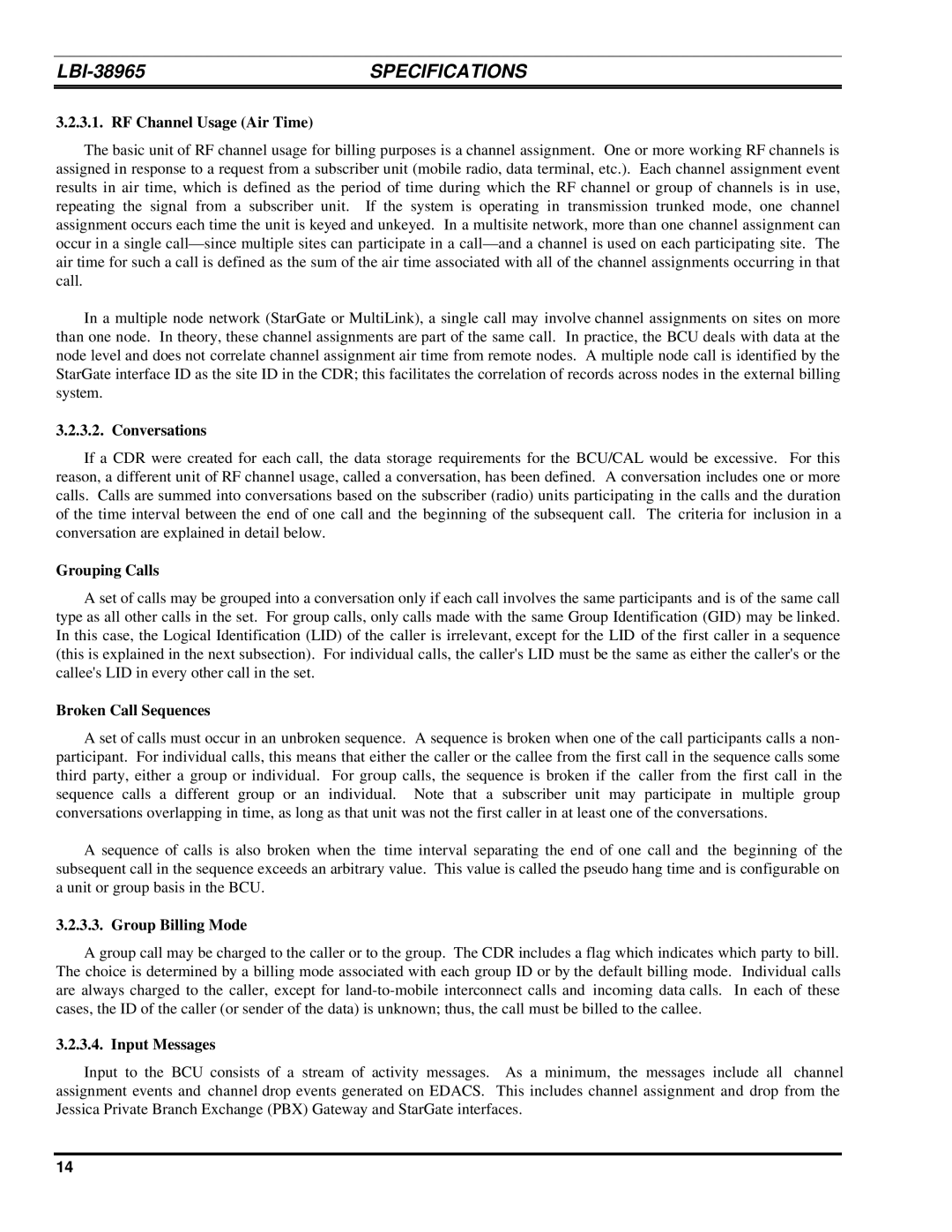
| SPECIFICATIONS |
3.2.3.1. RF Channel Usage (Air Time)
The basic unit of RF channel usage for billing purposes is a channel assignment. One or more working RF channels is assigned in response to a request from a subscriber unit (mobile radio, data terminal, etc.). Each channel assignment event results in air time, which is defined as the period of time during which the RF channel or group of channels is in use, repeating the signal from a subscriber unit. If the system is operating in transmission trunked mode, one channel assignment occurs each time the unit is keyed and unkeyed. In a multisite network, more than one channel assignment can occur in a single
In a multiple node network (StarGate or MultiLink), a single call may involve channel assignments on sites on more than one node. In theory, these channel assignments are part of the same call. In practice, the BCU deals with data at the node level and does not correlate channel assignment air time from remote nodes. A multiple node call is identified by the StarGate interface ID as the site ID in the CDR; this facilitates the correlation of records across nodes in the external billing system.
3.2.3.2. Conversations
If a CDR were created for each call, the data storage requirements for the BCU/CAL would be excessive. For this reason, a different unit of RF channel usage, called a conversation, has been defined. A conversation includes one or more calls. Calls are summed into conversations based on the subscriber (radio) units participating in the calls and the duration of the time interval between the end of one call and the beginning of the subsequent call. The criteria for inclusion in a conversation are explained in detail below.
Grouping Calls
A set of calls may be grouped into a conversation only if each call involves the same participants and is of the same call type as all other calls in the set. For group calls, only calls made with the same Group Identification (GID) may be linked. In this case, the Logical Identification (LID) of the caller is irrelevant, except for the LID of the first caller in a sequence (this is explained in the next subsection). For individual calls, the caller's LID must be the same as either the caller's or the callee's LID in every other call in the set.
Broken Call Sequences
A set of calls must occur in an unbroken sequence. A sequence is broken when one of the call participants calls a non- participant. For individual calls, this means that either the caller or the callee from the first call in the sequence calls some third party, either a group or individual. For group calls, the sequence is broken if the caller from the first call in the sequence calls a different group or an individual. Note that a subscriber unit may participate in multiple group conversations overlapping in time, as long as that unit was not the first caller in at least one of the conversations.
A sequence of calls is also broken when the time interval separating the end of one call and the beginning of the subsequent call in the sequence exceeds an arbitrary value. This value is called the pseudo hang time and is configurable on a unit or group basis in the BCU.
3.2.3.3. Group Billing Mode
A group call may be charged to the caller or to the group. The CDR includes a flag which indicates which party to bill. The choice is determined by a billing mode associated with each group ID or by the default billing mode. Individual calls are always charged to the caller, except for
3.2.3.4. Input Messages
Input to the BCU consists of a stream of activity messages. As a minimum, the messages include all channel assignment events and channel drop events generated on EDACS. This includes channel assignment and drop from the Jessica Private Branch Exchange (PBX) Gateway and StarGate interfaces.
14
